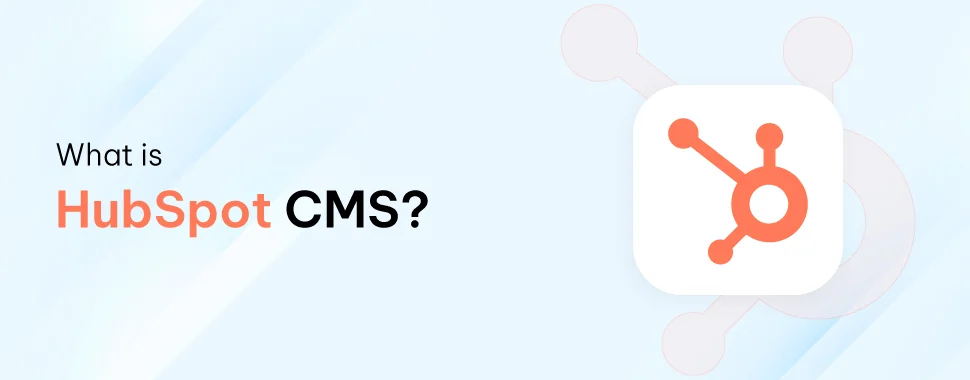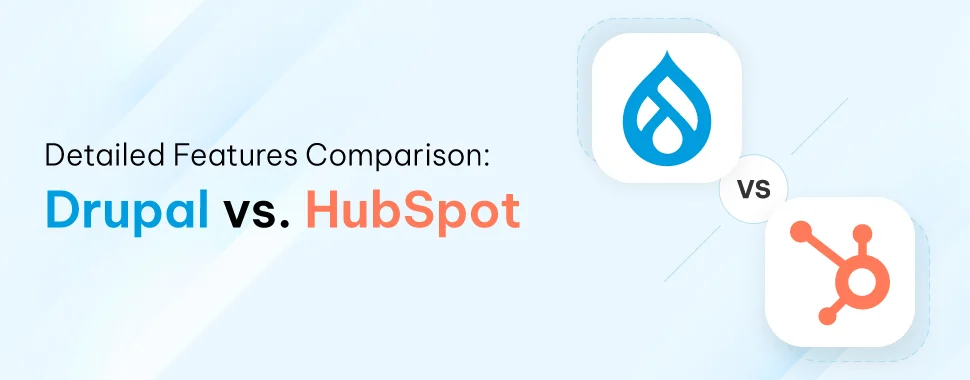Given today’s business competition, having a robust and flexible Content Management System (CMS) is important for businesses looking to establish a strong online presence. A CMS allows users to create, manage, and modify content on a website without requiring specialized technical knowledge.
Having said that, two of the most popular CMS platforms available today are Drupal and HubSpot. Each offers unique features and capabilities, catering to different needs and preferences.
What is Drupal?
Drupal is a free and open-source content management system (CMS) that is highly flexible, scalable, and customizable. It is designed to create and manage a wide range of digital content and is used by millions of websites worldwide.
Here’s what makes Drupal stand out:
- Open Source
- Customization and Flexibility
- Scalability
- Security
- Content Management
- Community Support
- Multilingual Support
Use Cases for Drupal
- Large Enterprises: Due to its scalability and security, Drupal is ideal for large organizations that need to manage vast amounts of content and handle high traffic.
- Government Websites: Its robust security features make it suitable for government sites that require stringent security measures.
- Educational Institutions: Drupal’s flexibility and customization options are perfect for universities and colleges that need to cater to diverse user needs.
What is HubSpot CMS?

HubSpot CMS is a cloud-based content management system that is part of the larger HubSpot platform, which includes marketing, sales, and service tools. It is designed to help businesses create, manage, and optimize their websites easily while integrating seamlessly with other HubSpot products.
Here’s a look at HubSpot CMS:
- Ease of Use
- Integrated Marketing Tools
- CRM Integration
- Content Management
- Analytics and Reporting
- Security and Hosting
- Customer Support
Use Cases for HubSpot CMS
- Small to Medium-Sized Businesses: HubSpot CMS is ideal for SMBs looking for an all-in-one solution to manage their website and marketing efforts without needing extensive technical resources.
- Marketing-Focused Websites: Its integration with HubSpot’s marketing tools makes it perfect for businesses focused on inbound marketing and lead generation.
- Service-Based Businesses: CRM integration is beneficial for businesses that need to manage customer relationships and track service interactions seamlessly.
Both Drupal and HubSpot CMS offer unique advantages tailored to different business needs. Drupal excels in flexibility, security, and scalability, making it suitable for large organizations with complex requirements. HubSpot CMS shines with its ease of use, integrated marketing tools, and CRM capabilities, catering primarily to SMBs and marketing-centric businesses.
Drupal vs. HubSpot: Features Comparison
| Feature | Drupal | HubSpot CMS |
|---|---|---|
| Ease of Use | Steeper learning curve, requires technical expertise | User-friendly interface, designed for non-technical users |
| Customization | Highly customizable with thousands of modules and themes | Limited customization compared to Drupal, but offers flexible templates |
| Scalability | Extremely scalable, suitable for high-traffic websites | Scalable, but primarily aimed at small to medium-sized businesses |
| Security | Strong security features, regularly updated by a dedicated team | In-built security measures, regular updates, and compliance certifications |
| Community and Support | Large, active community with extensive documentation and forums | Excellent customer support, extensive resources, and a knowledge base |
| SEO Tools | Requires additional modules for advanced SEO capabilities | Built-in SEO tools with recommendations and analytics |
| Integrated Marketing Tools | Limited native marketing tools, relies on third-party integrations | Comprehensive marketing tools, including automation, A/B testing, and analytics |
| CRM Integration | Third-party integrations available | Seamless integration with HubSpot CRM |
| Multilingual Support | Robust multilingual capabilities, supports multiple languages | Supports multiple languages but with less flexibility than Drupal |
| Content Management | Advanced content management features, suitable for complex workflows | Easy content management with a drag-and-drop editor and customizable templates |
| Performance | High performance with optimization techniques and caching | Reliable performance with built-in hosting and CDN |
| Cost | Open-source, but may incur costs for development, hosting, and maintenance | Subscription-based pricing, higher cost but includes hosting and support |
| Best For | Large enterprises, government sites, educational institutions | Small to medium-sized businesses, marketing-focused websites |
| Example Users | NASA, University of Oxford, White House | WWF, ClassPass, Trello |
📖 Also Read: Best Drupal Modules To Choose in 2025
Detailed Features Comparison: Drupal vs. HubSpot

1. Ease of Use
Drupal:
- Learning Curve: Drupal has traditionally been developer-focused, but recent updates with low-code/no-code tools and AI assistance make it more accessible to non-technical users.
- User Interface: The modernized admin UI and Gin Admin Theme improve navigation, while AI-powered tools assist with content creation and site-building.
- Content Creation: AI-driven content recommendations and guided workflows simplify publishing, while flexible content models offer customization without added complexity.
HubSpot CMS:
- Learning Curve: HubSpot CMS is designed to be user-friendly and accessible to non-technical users. It offers an intuitive drag-and-drop editor that simplifies the content creation process.
- User Interface: The interface is clean, modern, and easy to navigate, making it ideal for marketers and business users.
- Content Creation: Creating and managing content is straightforward, with built-in templates and modules that streamline the process.
2. Customization and Flexibility
Drupal:
- Modules and Themes: Drupal offers thousands of modules and themes that allow extensive customization of the website. Users can add features ranging from simple forms to complex workflows.
- Flexibility: Drupal’s architecture supports custom content types, views, and taxonomies, providing high flexibility to build tailored solutions.
- Development: Requires development skills to fully leverage its customization capabilities, making it suitable for projects with specific and complex requirements.
HubSpot CMS:
- Templates and Modules: HubSpot provides a range of customizable templates and modules but with less flexibility compared to Drupal. It is designed to balance ease of use with sufficient customization options.
- Flexibility: While not as flexible as Drupal, it offers enough customization for most small to medium-sized business needs, especially those focused on marketing and sales.
- Development: Minimal development skills are needed for basic customization, but more complex customizations might require developer assistance.
3. Scalability
Drupal:
- Handling Traffic: Drupal is built to handle high-traffic websites efficiently. Its performance can be optimized through caching, load balancing, and other techniques.
- Content Management: Can manage large volumes of content and users, making it ideal for enterprise-level applications.
- Growth: Scales well with the growth of the business, supporting complex structures and workflows.
HubSpot CMS:
- Handling Traffic: HubSpot CMS is also scalable but is primarily aimed at small to medium-sized businesses. It is hosted on HubSpot’s infrastructure, which ensures reliable performance.
- Content Management: Suitable for managing moderate volumes of content and traffic, but may require upgrades or additional services for very large-scale operations.
- Growth: Scales with business growth, particularly for companies focused on inbound marketing and customer relationship management.
4. Security
Drupal:
- Security Features: Drupal is known for its robust security features. It has a dedicated security team that regularly releases updates and patches.
- Community Support: The large community often identifies and addresses security vulnerabilities quickly.
- Compliance: Supports various compliance requirements, making it suitable for government and enterprise use.
HubSpot CMS:
- Security Features: HubSpot CMS includes built-in security measures such as SSL, a global CDN, and regular security updates.
- Hosted Solution: As a SaaS platform, HubSpot handles all hosting and security, reducing the burden on users.
- Compliance: HubSpot is compliant with various international standards and certifications, such as GDPR, ensuring data protection and privacy.
5. Community and Support
Drupal:
- Community: Drupal has a vast and active community with over a million members contributing to its development and support.
- Resources: Extensive documentation, forums, user groups, and events like DrupalCon provide valuable resources and support.
- Third-Party Support: Numerous agencies and developers specialize in Drupal, offering professional services.
HubSpot CMS:
- Community: While smaller than Drupal’s, HubSpot’s community is growing and active, particularly among marketers and business users.
- Resources: HubSpot offers comprehensive support, including a knowledge base, tutorials, and customer forums. Professional and enterprise customers receive 24/7 support.
- Customer Support: Known for excellent customer support, with dedicated support teams available to assist users.
6. SEO Tools
Drupal:
- SEO Modules: Requires additional modules like Yoast SEO or Metatag for advanced SEO capabilities.
- Customization: Highly customizable SEO settings, allowing granular control over URL structures, meta tags, and more.
- Performance: Optimized for high performance, which indirectly benefits SEO.
HubSpot CMS:
- Built-in Tools: Includes built-in SEO tools that provide recommendations and analytics to optimize content for search engines.
- Ease of Use: User-friendly SEO features designed for non-technical users, helping to improve search rankings without extensive SEO knowledge.
- Analytics: Integrated analytics tools provide insights into SEO performance, enabling data-driven decisions.
7. Integrated Marketing Tools
Drupal:
- Third-Party Integrations: Lacks native marketing tools but supports integrations with third-party marketing platforms like Marketo, Mailchimp, and HubSpot itself.
- Flexibility: Highly flexible in integrating various marketing tools, but requires more setup and configuration.
HubSpot CMS:
- Native Tools: Offers comprehensive marketing tools integrated into the CMS, including email marketing, social media management, and marketing automation.
- Unified Platform: Seamlessly integrates marketing, sales, and service tools, providing a unified experience.
- User Experience: Designed for marketers, making it easy to manage and optimize marketing campaigns directly from the CMS.
8. CRM Integration
Drupal:
- Third-Party CRM Integration: Supports integration with various CRM systems, including Salesforce, Zoho, and HubSpot, through modules and custom development.
- Flexibility: Offers flexible CRM integration options but may require technical expertise to implement.
HubSpot CMS:
- Native CRM: Fully integrated with HubSpot CRM, providing seamless access to customer data and interaction history.
- Ease of Use: Simplifies customer relationship management with built-in tools and automatic synchronization between CMS and CRM.
9. Multilingual Support
Drupal:
- Capabilities: Robust multilingual support with built-in capabilities for managing content in multiple languages.
- Customization: Allows for extensive customization of language settings, translations, and localization.
HubSpot CMS:
- Capabilities: Supports multiple languages, enabling users to create and manage multilingual websites.
- Ease of Use: While less flexible than Drupal, it provides a straightforward approach to managing multilingual content.
10. Content Management
Drupal:
- Advanced Features: Supports advanced content management features such as content versioning, complex workflows, and role-based access control.
- Customization: Highly customizable content types and fields, providing flexibility in how content is structured and displayed.
HubSpot CMS:
- Ease of Use: Provides an easy-to-use content management system with a drag-and-drop editor and customizable templates.
- Streamlined Management: Designed for ease of use, making content creation and management accessible to non-technical users.
11. Performance
Drupal:
- Optimization: High performance with optimization techniques such as caching, load balancing, and performance tuning.
- Handling Traffic: Can handle high-traffic websites efficiently, making it suitable for large-scale applications.
HubSpot CMS:
- Reliability: Reliable performance with built-in hosting, CDN, and regular updates to ensure site speed and uptime.
- Scalability: Scalable to handle growing traffic needs, particularly for small to medium-sized businesses.
12. Pricing:
Drupal:
- Initial Cost: Free (open-source)
- Development and Maintenance: Costs vary depending on the complexity of the project and the need for professional services.
- Hosting: Separate hosting costs, which can range from budget shared hosting to high-end dedicated servers.
HubSpot CMS:
- Starter Plan: Starting at $25/month
- Professional Plan: Starting at $400/month
- Enterprise Plan: Starting at $1,200/month
- Included Services: Hosting, security, customer support, and integrated marketing tools are included in the subscription.
Conclusion
Both Drupal and HubSpot CMS offer robust features tailored to different needs. Drupal is ideal for large enterprises and organizations requiring extensive customization, high security, and scalability. HubSpot CMS, on the other hand, is designed for small to medium-sized businesses and marketing-centric websites, offering ease of use, integrated marketing tools, and seamless CRM integration. Choosing between the two depends on your specific requirements, technical expertise, and budget.





